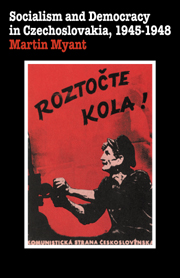Book contents
- Frontmatter
- Contents
- Acknowledgements
- Abbreviations
- Introduction
- 1 The development of the Communist Party of Czechoslovakia
- 2 War and occupation
- 3 The national revolution
- 4 The national revolution in Slovakia
- 5 Czech political parties
- 6 The Gottwald government
- 7 Deepening divisions
- 8 Prelude to February
- 9 The February crisis
- 10 Post-February Czechoslovakia
- Notes
- Bibliography
- Index
1 - The development of the Communist Party of Czechoslovakia
Published online by Cambridge University Press: 07 October 2011
- Frontmatter
- Contents
- Acknowledgements
- Abbreviations
- Introduction
- 1 The development of the Communist Party of Czechoslovakia
- 2 War and occupation
- 3 The national revolution
- 4 The national revolution in Slovakia
- 5 Czech political parties
- 6 The Gottwald government
- 7 Deepening divisions
- 8 Prelude to February
- 9 The February crisis
- 10 Post-February Czechoslovakia
- Notes
- Bibliography
- Index
Summary
THE ROAD TO A COMMUNIST PARTY
The Czechoslovak state came into being at the end of October 1918 out of the ruins of the Austro-Hungarian empire. Leadership in the new republic was soon in the hands of the progressive Czech politician Masaryk and his assistant Beneš. They had spent the war in emigration where they succeeded in creating an army of legionnaires from prisoners of war and deserters: it apparently numbered 128,000 men at the end of the war. This enabled them to win some measure of international recognition for a Czechoslovak state in the autumn of 1918 and Masaryk then returned home to be elected Czechoslovakia's first President. Beneš stayed in Paris to negotiate the Czechoslovak case at the peace conference. His strategy was to incorporate Czechoslovakia's cause into the emerging French strategy for Central Europe. This meant becoming part of a potential counter to German influence and a defence against the spread of ‘Bolshevism’.
He therefore advocated firm measures against opposition to the new state from the large German minority as this strengthened his standing at the peace conference where there was strong anti-German feeling. He also argued for the maximum show of domestic stability and this helped persuade the more right-wing members of the first Czechoslovak government to welcome the Social Democrats into the government and to allow the speedy enactment of social reforms including the eight-hour day, social insurance measures and emergency unemployment benefits.
- Type
- Chapter
- Information
- Socialism and Democracy in Czechoslovakia1945-1948, pp. 6 - 24Publisher: Cambridge University PressPrint publication year: 1981



